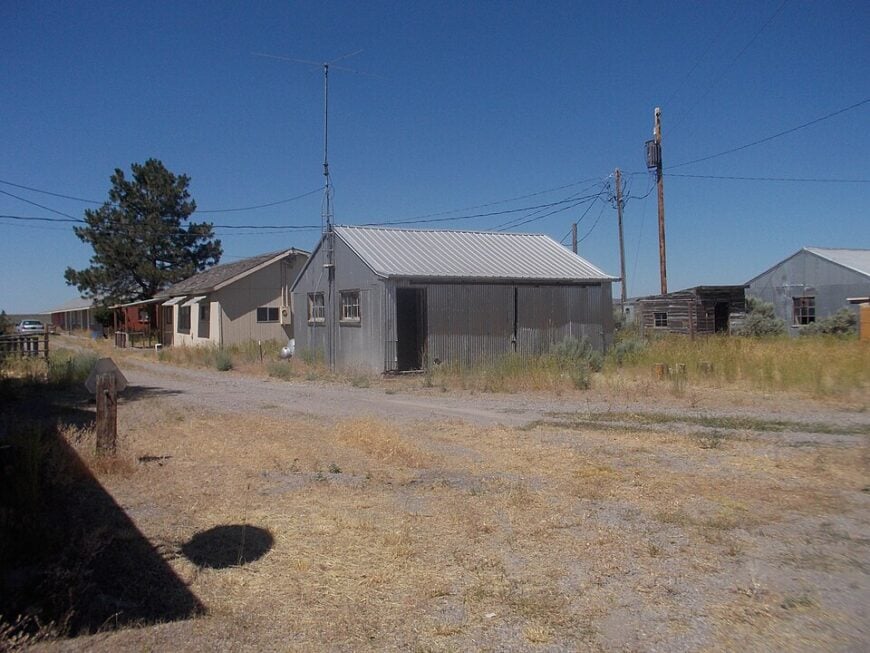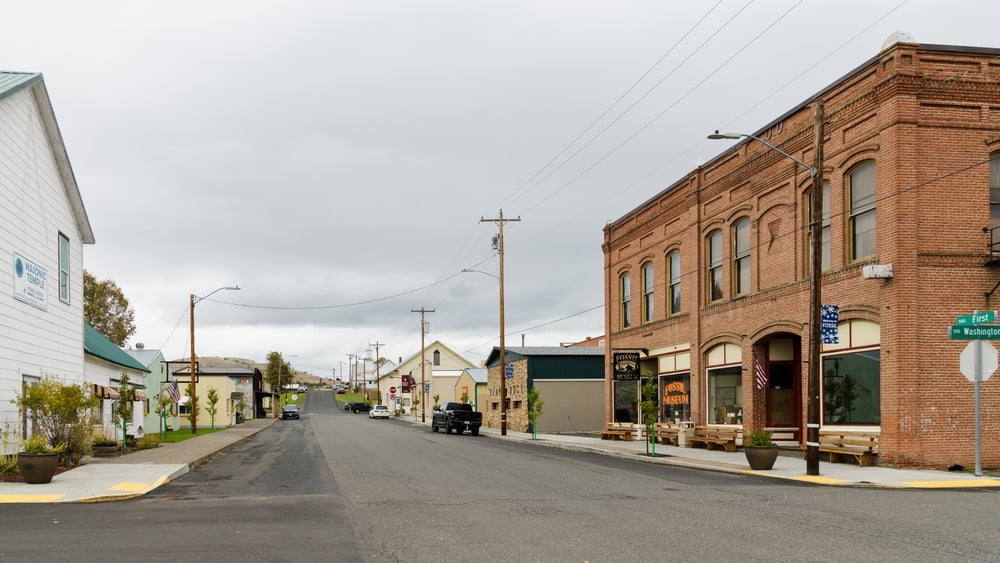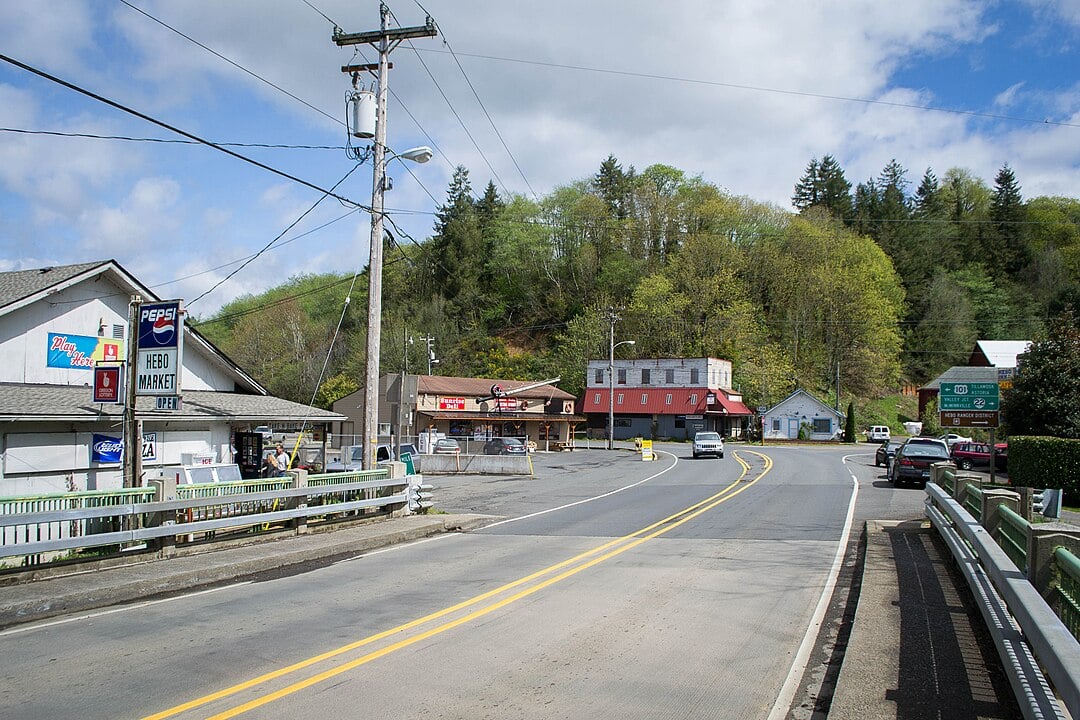Nestled within the vast expanse of Oregon’s Crooked River Valley lie some of the most secluded and tranquil towns you’ll ever encounter. These hidden gems offer a peaceful retreat from the hustle and bustle of city life, surrounded by stunning landscapes, rich history, and a sense of community that warms the soul. From near-forgotten mining towns to quiet ranching communities, each destination presents a unique glimpse into a life where nature and simplicity take center stage. Join us as we count down ten of the most secluded towns in this picturesque region, each offering its own blend of charm, solitude, and natural beauty.
10. Wagontire: Lost in the Landscape

With a population that can be counted on one hand, Wagontire is the epitome of seclusion. This tiny settlement once served as a stopover for travelers crossing the high desert but has since drifted into near obscurity. Visitors to Wagontire can explore the remnants of its past, including an old service station and motel that whisper stories of bygone days. The surrounding area offers vast open spaces perfect for stargazing, photography, or simply soaking in the silence of the desert. The mainstay here is solitude; there are no bustling industries, just the peaceful rhythm of the natural world. The town’s remoteness makes it a haven for those seeking an escape from modern life’s constant connectivity.
Where is Wagontire?

Located in Oregon’s high desert region, Wagontire sits along Highway 395 between the towns of Lakeview and Burns. Its isolated position, far from major cities and tucked away in the expansive landscape, contributes to its secluded nature. The lack of nearby amenities and services underscores the town’s solitude, making it feel like a place lost in time. To reach Wagontire, travelers embark on a long drive through the desert, where the horizon stretches endlessly, and encounters with other vehicles are few and far between.
9. Millican: A Deserted Haven

Millican is another nearly abandoned town with a current population of just a handful of residents. Once a modest ranching community, it now stands as a quiet testament to the passage of time. The town’s solitary store, which has served as a gas station, post office, and general store, remains a focal point for the few who pass through. Outdoor enthusiasts appreciate the area’s off-road trails and opportunities for wildlife viewing. There are no significant industries here; Millican’s allure lies in its emptiness and the untouched beauty of its desert surroundings. The town’s desolation offers a unique kind of peace that’s hard to find elsewhere.
Where is Millican?

Millican is situated approximately 25 miles east of Bend on Highway 20. Its location on the western edge of the high desert places it well away from urban centers. The town’s seclusion is heightened by the surrounding vast stretches of sagebrush and sand, with few signs of civilization nearby. Accessing Millican involves traveling through scenic but sparsely populated terrain, reinforcing the sense of stepping into a different world where nature dominates the landscape.
8. Hampton: Serenity in the High Desert

Hampton, with a population hovering around a dozen, is a quiet locale where the high desert’s expanse meets peaceful living. The town offers minimal amenities, but the true appeal lies in its serene environment and panoramic views of the desert and distant mountains. Activities here include bird watching, hiking, and enjoying breathtaking sunsets that paint the sky in vivid colors. Hampton doesn’t boast any major industries; it’s a place where simplicity reigns and the distractions of modern life feel distant. The seclusion is palpable, offering a retreat for those who value solitude and natural beauty.
Where is Hampton?

Found along Highway 20, Hampton is located about 60 miles east of Bend. Its position deep within the high desert contributes to its remote and isolated character. The town is surrounded by miles of open land, with the nearest neighboring communities quite a distance away. Traveling to Hampton involves a journey through expansive desert landscapes, further emphasizing the town’s seclusion and the serenity that comes with it.
7. Suplee: Off the Beaten Path

Suplee is an unincorporated community that truly lives up to the phrase “off the beaten path.” With a sparse population, it’s a haven for those looking to disconnect and immerse themselves in nature. The area is ideal for hiking, horseback riding, and exploring the rugged terrain that characterizes this part of Oregon. Ranching is the primary activity, reflecting a way of life that has remained relatively unchanged for generations. Suplee’s secluded nature is due to its remote location and the unspoiled environment that surrounds it, offering tranquility that is rare in today’s world.
Where is Suplee?

Suplee is tucked away in Crook County, southeast of Prineville. The community is accessible via a network of county roads that wind through picturesque landscapes. Its isolation is a result of both geography and the lack of significant development in the area. Reaching Suplee requires a deliberate effort, as it involves navigating rural routes that are far removed from major highways and urban centers, ensuring its peaceful ambiance remains undisturbed.
6. Antelope: Nature’s Refuge

Antelope is a small town with a rich and somewhat controversial history, now home to fewer than 50 residents. Surrounded by rolling hills and stunning natural scenery, it’s a refuge for those seeking a quiet lifestyle. Outdoor activities include hiking, bird watching, and exploring the remnants of historic structures that hint at the town’s past. Agriculture and ranching are prevalent, aligning with the area’s rural character. Antelope’s seclusion stems from its small population and the vast landscapes that envelop it, making it an ideal spot for connecting with nature.
Where is Antelope?

Located in Wasco County, Antelope sits north of the Ochoco National Forest and east of the Cascade Range. Its remote position is amplified by the limited road access and significant distance from larger towns. The town is reached via Highway 218, a route that meanders through scenic but sparsely populated areas. This isolation enhances Antelope’s charm for visitors and residents who appreciate the tranquility and natural beauty of the Oregon countryside.
5. Brothers: Where Silence Reigns

Brothers is a remote crossroads community with a population that barely reaches double digits. The town offers a solitary gas station and a small cafe, serving as a brief respite for travelers. The vast horizons and open skies provide a backdrop for stargazing and reflection. Ranching is the mainstay for the few who live there, embodying a rugged and self-sufficient lifestyle. Brothers’ seclusion is marked by its location amid the expansive high desert, where the silence is profound and the pace of life is unhurried.
Where is Brothers?

Situated on Highway 20, Brothers lies about 40 miles east of Bend. The town’s isolation is a product of its distance from urban areas and the stark, open landscapes that surround it. Getting to Brothers involves traveling through stretches of desert where services are minimal and encounters with other travelers are rare. This remoteness is a defining characteristic, drawing in those who seek solitude and a deep connection with the natural environment.
4. Gateway: A Hidden Passage

Gateway is a small, unincorporated community that serves as a literal and figurative gateway to unspoiled landscapes. With a modest population, it’s a secluded spot that offers access to outdoor adventures like hiking and exploring the nearby Deschutes River canyon. The area is steeped in history, with old homesteads and railroads hinting at its past significance. There are no major industries in Gateway; the community thrives on its close-knit nature and the beauty of its surroundings. Its seclusion offers a peaceful retreat for those looking to escape the crowds.
Where is Gateway?

Located in Jefferson County, Gateway sits east of Mount Jefferson and is accessible via local county roads branching off Highway 97. The town’s hidden nature is due to its positioning away from main thoroughfares and the rugged terrain that encircles it. Traveling to Gateway involves navigating lesser-known routes that showcase Oregon’s diverse landscapes. This journey off the beaten path contributes to the town’s secluded ambiance and appeal.
3. Ashwood: Ghost Town Echoes

Ashwood is a near-forgotten town where historic buildings whisper of a bygone mining era. With a population of around 20 residents, it offers a glimpse into Oregon’s past, complete with remnants of old mines and structures from the early 1900s. Visitors can explore the area’s rich geological features, including agate beds and petrified wood—a treasure trove for rock enthusiasts. The lack of active industries today emphasizes the town’s quietude and historical significance. Ashwood’s seclusion is a draw for those intrigued by ghost towns and the stories they hold.
Where is Ashwood?

Ashwood is nestled in Jefferson County, northeast of Madras. The town is accessible via a series of winding county roads that traverse through scenic high desert landscapes. Its remote location and the surrounding rugged terrain reinforce its status as a secluded destination. Reaching Ashwood means venturing away from well-traveled highways, adding to the sense of stepping back in time and away from the modern world.
2. Paulina: A Rustic Retreat

Paulina is a remote community nestled in the heart of the Crooked River Valley, offering a genuine slice of rural life. With around 150 residents, the town is a hub for ranching and agriculture, reflecting the traditions of the region. Visitors can enjoy activities such as fishing in the Crooked River, exploring nearby forests, and participating in local events that celebrate the community’s heritage. Paulina’s seclusion is attributed to its distance from larger towns and the encompassing natural landscapes that provide a buffer from the outside world.
Where is Paulina?

Located in Crook County, Paulina is situated east of Prineville, accessible via Highway 380. The town’s remote position deep within the valley enhances its secluded atmosphere. The journey to Paulina involves traversing scenic routes that cut through forests and alongside rivers, highlighting the region’s natural beauty. This remoteness ensures that Paulina remains a tranquil retreat, ideal for those seeking a connection with nature and a slower pace of life.
1. Post: The Heart of Nowhere

Post holds the distinction of being the geographic center of Oregon, a quiet hamlet known for its secluded ranches and open skies. With a tiny population, the community centers around a general store that also serves as a post office and gathering place. The area offers opportunities for fishing, hiking, and experiencing the wide-open spaces that define the region. Ranching dominates the local industry, continuing a way of life that has persisted for generations. Post’s seclusion is not just geographical but also a state of mind, offering a retreat into simplicity and the rhythms of nature.
Where is Post?

Situated in Crook County, southeast of Prineville, Post is accessible via Highway 380. Its central location in the state belies its remoteness, as it remains far from major cities and commercial centers. The town is surrounded by vast stretches of rangeland and rolling hills, contributing to its isolated feel. Reaching Post involves a drive through scenic countryside, reinforcing the sense of departure from the busy modern world and entry into a place where time moves a bit slower.






